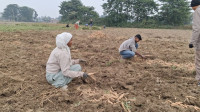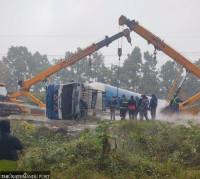National
Public health experts warn of community spread of virus as Valley reports 53 new cases
With the lockdown declared over and increased public movement, doctors say contact tracing will be more difficult, and Kathmandu could turn into a Covid-19 hotspot.
Arjun Poudel
The Ministry of Health said on Tuesday that 53 new Covid-19 cases were reported in Kathmandu Valley, the highest for a single day, raising an alarm, as public health experts warned of community spread of the virus.
Of the 48 cases reported in Kathmandu district, 27 are Nepal Police personnel, according to the ministry. Four cases were reported from Lalitpur and one from Bhaktapur.
Four people who tested positive for Covid-19 had come in contact with the police personnel infected with the virus, according to Dr Basudev Pandey, director at the Epidemiology and Disease Control Division. Likewise, 13 others who tested positive for the virus had entered the Valley recently.
Public health experts said the Valley could become a new hotspot for various reasons–it is densely populated, people’s movement is not regulated and safety measures are not being followed.
“Rise in the number of positive cases in Kathmandu Valley is very alarming,” said Dr Baburam Marasini, former director at the Epidemiology and Disease Control Division. “Negligence coupled with some immature decisions on the part of authorities concerned could lead to a disaster.”
With 53 new cases, the number of positive cases in Kathmandu Valley has now reached 477. The Covid-19 national tally so far has reached 19,063, with 49 deaths.
When the government on July 21 decided to lift the four-month-long lockdown, there were concerns that the decision might have been taken in haste.
Public health experts have for long alleged that the government failed to utilise the lockdown period to improve quarantine facilities and expand polymerase chain reaction tests.
“Kathmandu Valley can become a new Covid-19 hotspot in the coming days,” Marasni told the Post. “The government has neither increased the number of tests nor enforced safety measures properly.”
Though the government has allowed public transport to resume only within the Valley, data suggests people in thousands of numbers are entering Kathmandu every day. According to the Ministry of Home Affairs, over 5,000 people enter the Valley every day using emergency vehicles and cargo trucks and by taking special permissions.
“The rise in the number of cases is something I was expecting,” said Dr Sher Bahadur Pun, chief of the Clinical Research Unit at Sukraraj Tropical and Infectious Disease Hospital. “Public movement has increased like in the pre-lockdown phase. This is also an indication of what is going to happen in coming days.”
According to Pun, failure to break the chain of infections could spell a disaster, as the virus could rapidly spread to the community.
“We can’t say what will happen then,” said Pun.
Since the end of the lockdown on July 21, a total of 28,072 PCR tests have been conducted, compared to 30,096 tests performed in the seven days leading to the lockdown.
Doctors have long been asking the authorities to expand tests, conduct contact tracing, improve quarantine centres and raise awareness among the public.
With the highest number of infections for a single day recorded in the Valley, authorities on Tuesday were scrambling to trace people who may have come into contact with those who have tested positive.
Of the 53 who tested positive for the virus in the Valley in the last 24 hours, the contacts of nine people are yet to be traced.
According to Pandey of the Epidemiology and Disease Control Division, contact tracing of the infected people has already begun.
“We are working to find the contacts of all the infected people and their travel history.”
Contact tracing, however, is not easy given the increased movement of people after the lifting of the lockdown.
“During the lockdown, people stayed put in their houses and even if there was movement, it was limited to their own locality. This meant they would come in contact with a limited number of people,” said Pun. “Since the end of the lockdown, we are behaving as if there is no threat of the virus. This will make contact tracing even more complicated.”
After the government lifted the lockdown, public experts had told the Post that the threat level was still high.
Doctors said that their suggestions were overlooked while taking the decision to end the lockdown and resume public transportation as well as other businesses.
“We had asked the government to lift restrictions in areas where the risk was low,” Dr Senendra Upreti, a former health secretary, told the Post. “But without taking the consequences into consideration, the government ended the lockdown at one go throughout the country.”
The Ministry of Health itself is anticipating the number of positive cases to rise, but it has shifted its responsibilities to the shoulders of the people.
“The number of cases will go up in the coming days if we keep violating the safety rules,” said Jageshwor Gautam, spokesperson for the Ministry of Health. “What can we do if people don’t follow safety instructions?”
Public health experts say while it is incumbent on people to follow safety protocols–wear masks, maintain social distancing and hygiene, avoid visiting crowded places and limit their movement–authorities need to play a bigger role.
Marasini said that the local administration can play an important role in regulating public movement, making masks mandatory in public places and enforcing social distancing rules.
Pun said the writing was on the wall when authorities were too slow to recognise the virus threat.
“First we made a mistake by underestimating the risk, and now we are repeating the mistakes that some countries like India and the US made,” said Pun. “Contact tracing will become more challenging in the coming days. If we fail to act now, we are headed for a disaster.”




 6.12°C Kathmandu
6.12°C Kathmandu













%20(1).jpg&w=300&height=200)

